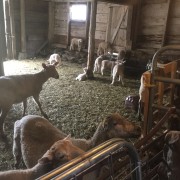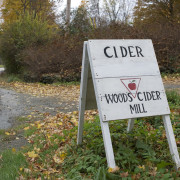Hartland’s Lamb Farm Conserved with the Upper Valley Land Trust
 On November 18, during a special meeting of the Hartland Conservation Commission, Anna Lamb signed documents that will ensure that the 67 acres of scenic open fields and forest that make up the Lamb Farm remain undeveloped forever. The Upper Valley Land Trust will uphold the conservation easement restrictions, while the family will continue to own and farm the land, and care for its many resources. Visible to travelers exiting Interstate 91, this land was preserved with funds from the federal Transportation Enhancements program through the Vermont Agency of Transportation. In addition, the Hartland Conservation Commission served as a critical partner, providing the matching funds needed to keep this working agricultural land available for future generations to enjoy.
On November 18, during a special meeting of the Hartland Conservation Commission, Anna Lamb signed documents that will ensure that the 67 acres of scenic open fields and forest that make up the Lamb Farm remain undeveloped forever. The Upper Valley Land Trust will uphold the conservation easement restrictions, while the family will continue to own and farm the land, and care for its many resources. Visible to travelers exiting Interstate 91, this land was preserved with funds from the federal Transportation Enhancements program through the Vermont Agency of Transportation. In addition, the Hartland Conservation Commission served as a critical partner, providing the matching funds needed to keep this working agricultural land available for future generations to enjoy.
 The Lamb Farm is situated west of Route 5 in Hartland, VT in the Connecticut River Valley. It is a picturesque hillside farm along the lower eastern slopes of Tinkham Hill. More than 41 acres of open land on the property are among the first farm fields seen as travelers approach the Hartland Three Corners. Used for hay production and grazing cattle, the fields contain valuable agricultural soils considered to be of statewide significance.
The Lamb Farm is situated west of Route 5 in Hartland, VT in the Connecticut River Valley. It is a picturesque hillside farm along the lower eastern slopes of Tinkham Hill. More than 41 acres of open land on the property are among the first farm fields seen as travelers approach the Hartland Three Corners. Used for hay production and grazing cattle, the fields contain valuable agricultural soils considered to be of statewide significance.Portions of the Lamb Farm also lie within an area identified as an Ecological Hot Spot by the Vermont Biodiversity Project. These Hot Spots are identified based on the density of rare, threatened and endangered species within a given area. A wetland nearby on Tinkham Hill supports a Red Maple – Black Ash Seepage Swamp, and is host to a rare plant species. While rare, endangered, or threatened species have not been identified on the Lamb property, its protection will add valuable supporting habitats to help maintain biodiversity in the region.
The Upper Valley Land Trust has conserved approximately 420 acres of land within two miles of the Lamb Farm, which is in addition to more than 300 acres of other conserved or public lands. The Lamb Farm fields are part of Hartland’s historic landscape and are an important representation of the contribution farming has made to the growth and sustenance of the town. The recent conservation easement will ensure that these fields will continue to be a part of Hartland’s working landscape for generations to come. 



